Question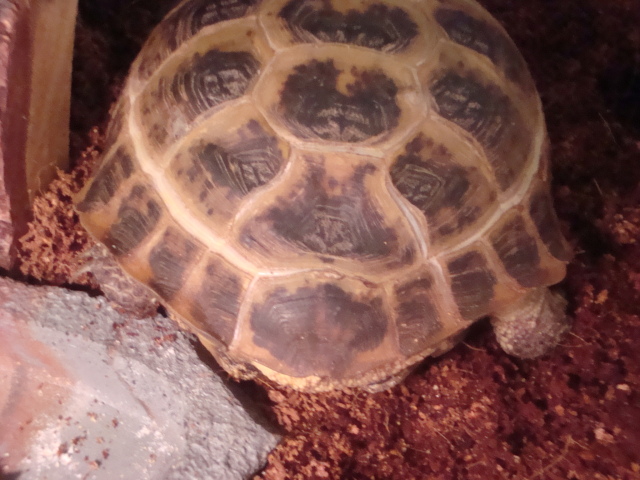 Walkers Shell
Walkers Shell
QUESTION: I have a male Russian Tortoise that we have had for about 2
months. I do not know how old he is or if he was caught in
the wild. I purchased him from an aquarium store. They
didn't give me any papers on him or anything, so I really
don't know his history. He is about 5 or 6 inches in size.
My fault. I honestly did not research this nearly enough. We
currently do not have the means to build the size of
Tortoise table that we would like, and we live in Maryland,
so it is too cold now to keep him outside. His habitat is
around a 48 gallon Rubbermaid container. We would like to
get a 55 gallon soon. His substrate is made of about 75%
Coconut Coir from Carolina Supply and 25% play sand. The
humidity of his habitat stays at about 60% to 70%. I re-wet
it when it gets lower than 60. He has a bath of water for
dipping and drinking and a wood cave for shade. He was using
a 50W ex-terra bulb for heating, but it has turned cold, so
I upped it to a 75 W. His temp in his habitat stays at about
85-95 degrees F under the lamp and at about 75 Degrees F in
the shade. Now that is is cooler, the tank drops to about 70
Degrees F during the night. We feed him every day. I read
that you ought to feed them every day as much as they can
eat in 20 minutes. He gets Kale, Collards, Spinach, and some
occasional yellow squash, carrots, or apples. I also keep
some organic pellets in there that are made of alfalfa and
other grassland greenery. I sprinkle cuttle bone shavings on
his food about twice a week. I also put him in a warm bath
up to just above the bottom of his shell 2 to 3 times per
week.
My concern is this. He is usually a very good eater. Active.
He does the normal behavior, cool end, hot end, roam, etc.
However, I began noticing a difference in the look of his
shell about 2 weeks ago. I have attached a picture. If you
look at the lines that link the sections of his shell
together, it almost looks as if the sections are staying
where they are, but the underneath is growing . . . like
white bone is showing through. It only shows like this in
between the sections, so I don't think it is pyramiding or
shell rot, but I am not sure. The biggest worry with this is
that as of about 5 days ago, he stopped eating. He will eat
a little bite or two here and there, but nothing like he
used to and there were several days where he wouldn't take a
single bite, even when I added squash . . . his favorite. He
is also less active. He is active and alert when I take him
out, but he mostly has been burying himself and sleeping all
the time. Do they hibernate? Is he sick? I am so worried
about him. His eyes look clear, no discharge. His nose is
clear too. Any suggestions.
Also, should I clip his nails? They seem awfully long, but
the pet store guys said I wouldn't need to. I think I
should. If so, how short can I go without hurting him?
Any tips would be great! Thank you so much!
ANSWER: Hi Heidi,
Walker is definitely wild caught, so at least five years old and likely older. The good news is that the white you see is just new shell growth, so is pefectly normal. The color will darken over time. The bad news (well, not really so bad) is that you do need to make some changes to keep him healthy.
Upgrade to the largest rubbermaid bin as soon as you can. It's still not really big enough, but better. Next spring, build him an outside enclosure so he can spend time getting natural sunlight and grazing, and it'll be the best way to keep him on the right path.
The substrate mix you have is good, but it should be 50% coir and 50% playsand. Sounds like you're keeping it damp enough, so that's good. Your temperatures are more or less fine, although you want basking temps closer to 90-95. However, you're not using a UVB and that alone may account for his inactivity. Tortoises must have a source of UVB in order to metabolize calcium. The easiest way to do this indoors is to use a combination heat/UVB bulb. Right now what I would recommend is using the ZooMed Powersun (100 watt). It should be on a minimum of 12 hours a day, and at this time of year you may need to increase the time to 14+ hours a day if the tortoise remains inactive.
As far as diet goes, feed leafy greens. No veggies, no fruit, and no pellets. Russians will sometimes eat a little grass or hay, but not much. Good greens are turnip, dandelion, collards, mustard, kale, endive, romaine and other types of lettuce (limited), plus weeds and flowers such as chicory, sow thistle, clover, plantain, mallow, hawkbit, chickweed, hibiscus, abutilon, grape/mulberry leaves, prickly pear cactus, violas, and nasturtiums. If you want to provide hay (and I wouldn't bother myself), orchard grass is a good choice--alfalfa has too much protein.
Overall, I think your care is good and with a few small changes he should perk up. Just make sure you have a good UVB bulb and that it's on long enough each day. Russians do hibernate, but any lethargic behavior *indoors* is not due to hibernation--at most, you might see a minor slowdown due to changes in light. If he remains lethargic after you change things, you should probably take him to a vet for an exam and fecal check.
You can trim his nails, but normally a Russian's nails are somewhat long so that they can climb and dig, and will self-trim. In an indoor enclosure the ability to self-trim might be more limited, so if need be, just clip the tips of the nails (the clear part). If you get him outside next year, most likely excessive nail growth won't be a problem.
You've probably already seen this website, but the best care information is at www.russiantortoise.org. If you have more questions, please post back!
---------- FOLLOW-UP ----------
QUESTION: Thank you so much for the information! What a relief that
his shell is okay. I think you answered everything. I just
want to make sure. As far as his lack of eating. Do you
think it is because of the temperature or lack of variety of
foods? Also, is feeding him once per day fine? Is it normal
for them to skip a day here and there? Maybe we just spoiled
him too much with other things besides greens that it will
take him a but to adjust? Also, with the flowers, do you
give the whole flower (petals and all) or just the leaves?
With weeds, can I just pick them from outside? Pesticides
worry me. Thank you so much! I love this website!!
ANSWER: I think the lack of appetite may be due to lack of UVB, temps a bit too low, not enough (artificial) daylight, or possibly parasites. It wouldn't be due to his diet not being varied enough. The main reason for a varied diet is that different greens will provide different nutrients, and also to prevent the tortoise getting addicted to any one food (romaine lettuce is notorious for this). Feeding an adult tortoise once a day is fine as long as you don't overfeed. Feeding every other day is fine, too. Sometimes they may skip a meal, and that's nothing to be concerned about unless it continues. Usually a loss of appetite means temperatures are too hot or cool, the tortoise is too dry, or it has parasites/illness.
You can feed whole flowers. They particularly love dandelion flowers if you can get them. Weeds from the yard or elsewhere are OK, but you need to be sure they're not chemically treated (same goes for any plants/flowers). You can also buy weed seeds from www.carolinapetsupply.com for planting in an outdoor enclosure next spring if you have cold winters. This is what I do for my tortoises, and that way they are able to feed themselves throughout the summer.
I think if you get a new bulb with UVB you'll see a big change in his behavior. If you put the light on a lamp timer, you won't have to worry about turning it on and off and he'll have consistent daylight time, too. Let me know if I can be of further help!
---------- FOLLOW-UP ----------
QUESTION: I have been using the 100 W bulb with UVB that you
recommended, but his habitat is still staying at slightly
under 90 Degrees F under the lamp. I have the bulb in a Zoo
Med Mino Dome Lamp. This is the one I already had. Should I
get the Zoo Med Deep Dome Lamp instead? The buld packaging
recommended the deep dome lamp because it has to have a
ceramic or porcelain base. He is in a larger habitat now as
you recommended as well and I have changed up his diet. He
seems to be doing better, but I think his habitat is still
too cool. I have an undertank heater that I turn on at
night. It is on the end where the lamp is since this is
where he used to finding warmth. The opposite end of his
house is getting down to like 70 to 72 degrees F during the
day. Should I put an undertank heater on that end too and
keep it on during the day. He never goes to the cooler end
anymore. Right now the house is pretty cold. It stays at
about 68 Degrees F. Any suggestions?
AnswerHi Heidi,
First off, I think allexperts only lets you post three times under one question. So if you need to post back, you'll probably have to post a new question--which is fine, but if you post it as *private*, I'll give you my email and we can just correspond directly.
The heat/UVB bulbs normally have a minimum distance requirement of 12" from the substrate surface, so you can lower the bulb if it's higher than this (I use ZooMed lamp stands, as they're very stable and easy to adjust). You do need to use a fixture with a ceramic base for the bulb--this is VERY important, as there is a fire risk otherwise, so if your current fixture doesn't have the ceramic socket, go ahead and get the Deep Dome.
The basking temperature is the most important. The temperature of the cool area is less important as long as you have that warm basking area and keep the light on for a sufficient number of hours. In the winter my house is never as warm as 68 degrees and my tortoises are just fine with that. You don't need the undertank heater at night (and in any case tortoises should only have heat from above)--as long as your house stays above 50 degrees at night, it's warm enough. Russian tortoises need a drop in temperatures at night and tend to become sluggish if they're too warm. So don't worry about that.
Also don't worry about him staying on the warmer side most of the time. Tortoises are very good at regulating their body temperature, and all that means is that he doesn't need to cool off very often. If you get the basking temperature up in the 90-95 range, you may see him on the cool side more often (or not).
How is he doing otherwise? Is he starting to eat?


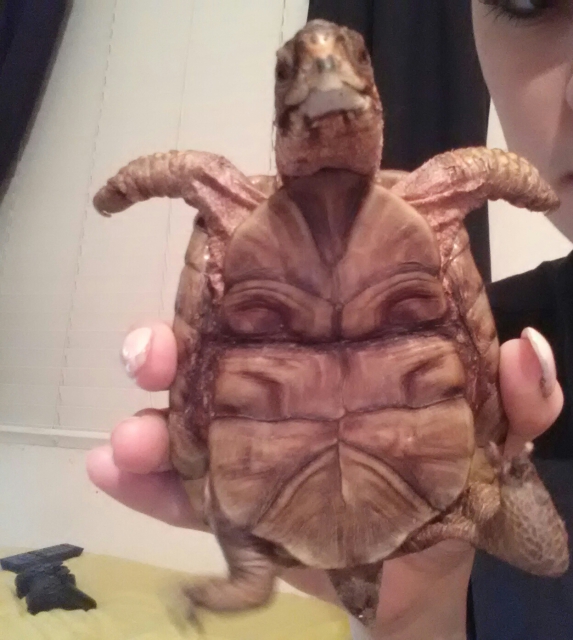 What kind of turtle I have
Question
Honey 1 Honey 2
Hi, I have had th
What kind of turtle I have
Question
Honey 1 Honey 2
Hi, I have had th
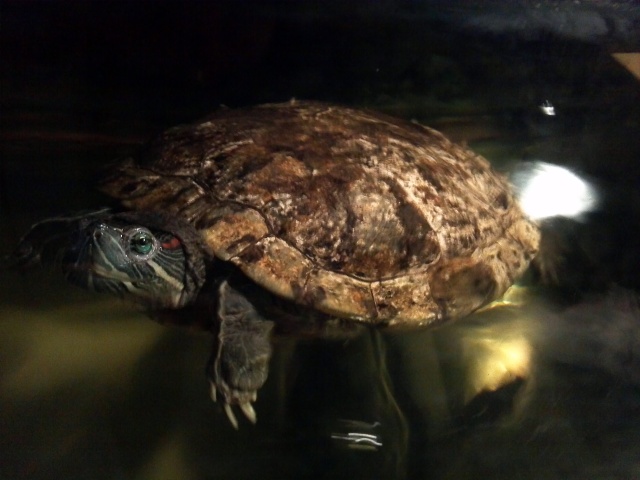 Brown Shell
Question
Freddy
This is freddy, ive had her for
Brown Shell
Question
Freddy
This is freddy, ive had her for
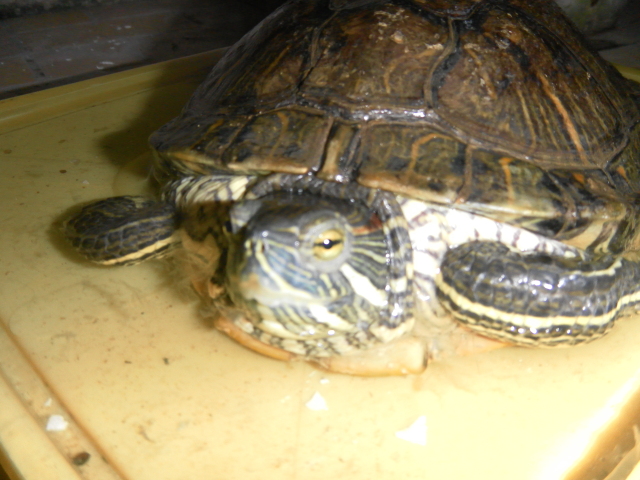 obese
Question
obese
i attached pictures of my turtle, is she
obese
Question
obese
i attached pictures of my turtle, is she
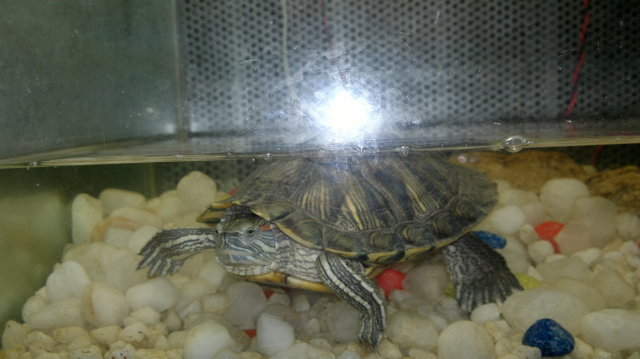 my tortise has stop eating
QuestionQUESTION: I am having 1 tortoise since 1 year b
my tortise has stop eating
QuestionQUESTION: I am having 1 tortoise since 1 year b
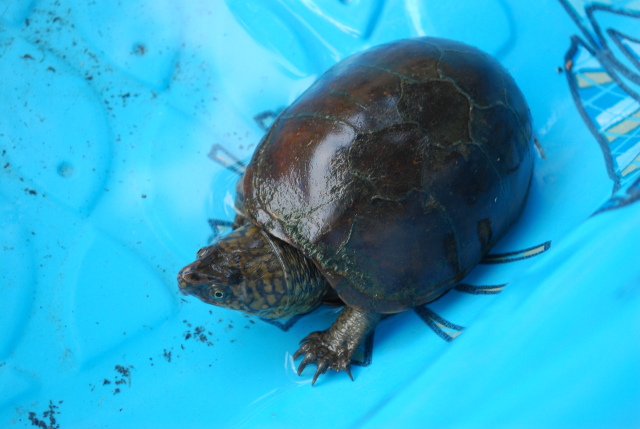 What is my turtle?
QuestionNew Turtle
QUESTION: I have a turtle tha
What is my turtle?
QuestionNew Turtle
QUESTION: I have a turtle tha